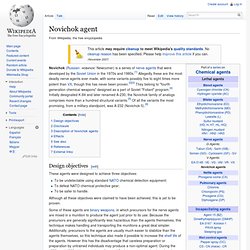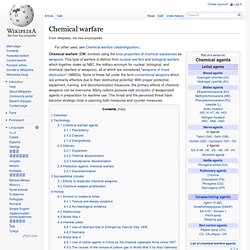

US rejects destroying chemical weapons. List of chemical warfare agents - Wiki. A chemical weapon agent (CWA) is a chemical substance whose toxic properties are used to kill, injure or incapacitate human beings.

About 70 different chemicals have been used or stockpiled as chemical weapon agents during the 20th century. These agents may be in liquid, gas or solid form. In general, chemical weapon agents are organized into several categories according to the physiological manner in which they affect the human body. Division may also be by tactical purpose or chemical structure. The names and number of categories varies slightly from source to source, but in general, types of chemical warfare agents are as follows: Harassing agents[edit] These are substances that are not intended to kill or injure. Tear agents[edit] These sensory irritants produce immediate pain to the eyes and irritate mucous membranes (aka lachrymatory agent or lachrymator).
Vomiting agents[edit] These sensory irritants are also termed sternators or nose irritants. List of chemical warfare agents - Wiki. Anticholinergic - Wiki. An anticholinergic agent is a substance that blocks the neurotransmitter acetylcholine in the central and the peripheral nervous system.

Anticholinergics inhibit parasympathetic nerve impulses by selectively blocking the binding of the neurotransmitter acetylcholine to its receptor in nerve cells. The nerve fibers of the parasympathetic system are responsible for the involuntary movement of smooth muscles present in the gastrointestinal tract, urinary tract, lungs, etc. Anticholinergics are divided into three categories in accordance with their specific targets in the central and/or peripheral nervous system: antimuscarinic agents, ganglionic blockers, and neuromuscular blockers.[1]
Acetylcholinesterase inhibitor - Wiki. Acetylcholinesterase inhibition An acetylcholinesterase inhibitor (often abbreviated AChEI) or anti-cholinesterase is a chemical that inhibits the acetylcholinesterase enzyme from breaking down acetylcholine, thereby increasing both the level and duration of action of the neurotransmitter acetylcholine.

Reversible, quasi-irreversible (or pseudirreversible in some sources) and irreversible inhibitors exist.[1] Uses[edit] Acetylcholinesterase inhibitors:[2] Effects[edit] Some major effects of cholinesterase inhibitors: Administration of reversible cholinoesterase inhibitors is contraindicated with those that have urinary retention due to obstruction. Titration phase[edit] When used in the central nervous system to alleviate neurological symptoms, such as rivastigmine in Alzheimer's disease, all cholinesterase inhibitors require doses to be increased gradually over several weeks, and this is usually referred to as the titration phase. Nerve agent - Wiki.
Nerve agents are a class of phosphorus-containing organic chemicals (organophosphates) that disrupt the mechanism by which nerves transfer messages to organs.

The disruption is caused by blocking acetylcholinesterase, an enzyme that normally destroys acetylcholine, a neurotransmitter. As chemical weapons, they are classified as weapons of mass destruction by the United Nations according to UN Resolution 687 (passed in April 1991) and their production and stockpiling was outlawed by the Chemical Weapons Convention of 1993; the Chemical Weapons Convention officially took effect on April 29, 1997.
The use of dangerous gases in warfare is forbidden by treaties already in the Hague Conventions of 1899 and 1907 and Geneva Protocol of 1925. Poisoning by a nerve agent leads to contraction of pupils, profuse salivation, convulsions, involuntary urination and defecation, and eventual death by asphyxiation as control is lost over respiratory muscles. Biological effects[edit] Novichok agent - Wiki. Design objectives[edit] These agents were designed to achieve three objectives: To be undetectable using standard NATO chemical detection equipment;To defeat NATO chemical protective gear;To be safer to handle.

Although all these objectives were claimed to have been achieved, this is yet to be proven. Some of these agents are binary weapons, in which precursors for the nerve agents are mixed in a munition to produce the agent just prior to its use. Because the precursors are generally significantly less hazardous than the agents themselves, this technique makes handling and transporting the munitions a great deal simpler. Disclosure[edit] Extremely potent third-generation chemical weapons were developed in the Soviet Union and Russia from the 1970s until the early 1990s, according to a publication by two chemists, Lev Fedorov and Vil Mirzayanov in Moskovskiye Novosti weekly in 1992.[7] The publication appeared just on the eve of Russia's signing of the Chemical Weapons Convention. Chemical warfare - Wiki. Chemical warfare (CW) involves using the toxic properties of chemical substances as weapons.

This type of warfare is distinct from nuclear warfare and biological warfare, which together make up NBC, the military acronym for nuclear, biological, and chemical (warfare or weapons), all of which are considered "weapons of mass destruction" (WMDs). None of these fall under the term conventional weapons which are primarily effective due to their destructive potential.
With proper protective equipment, training, and decontamination measures, the primary effects of chemical weapons can be overcome. Many nations possess vast stockpiles of weaponized agents in preparation for wartime use. The threat and the perceived threat have become strategic tools in planning both measures and counter-measures. Marketing new chemical weapons.